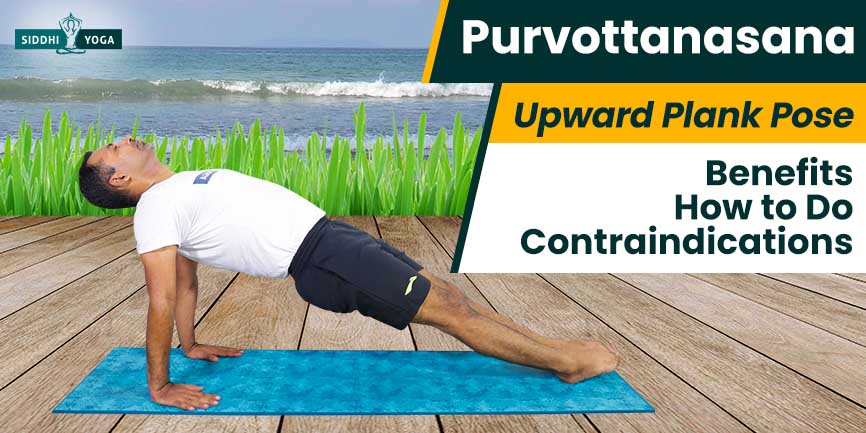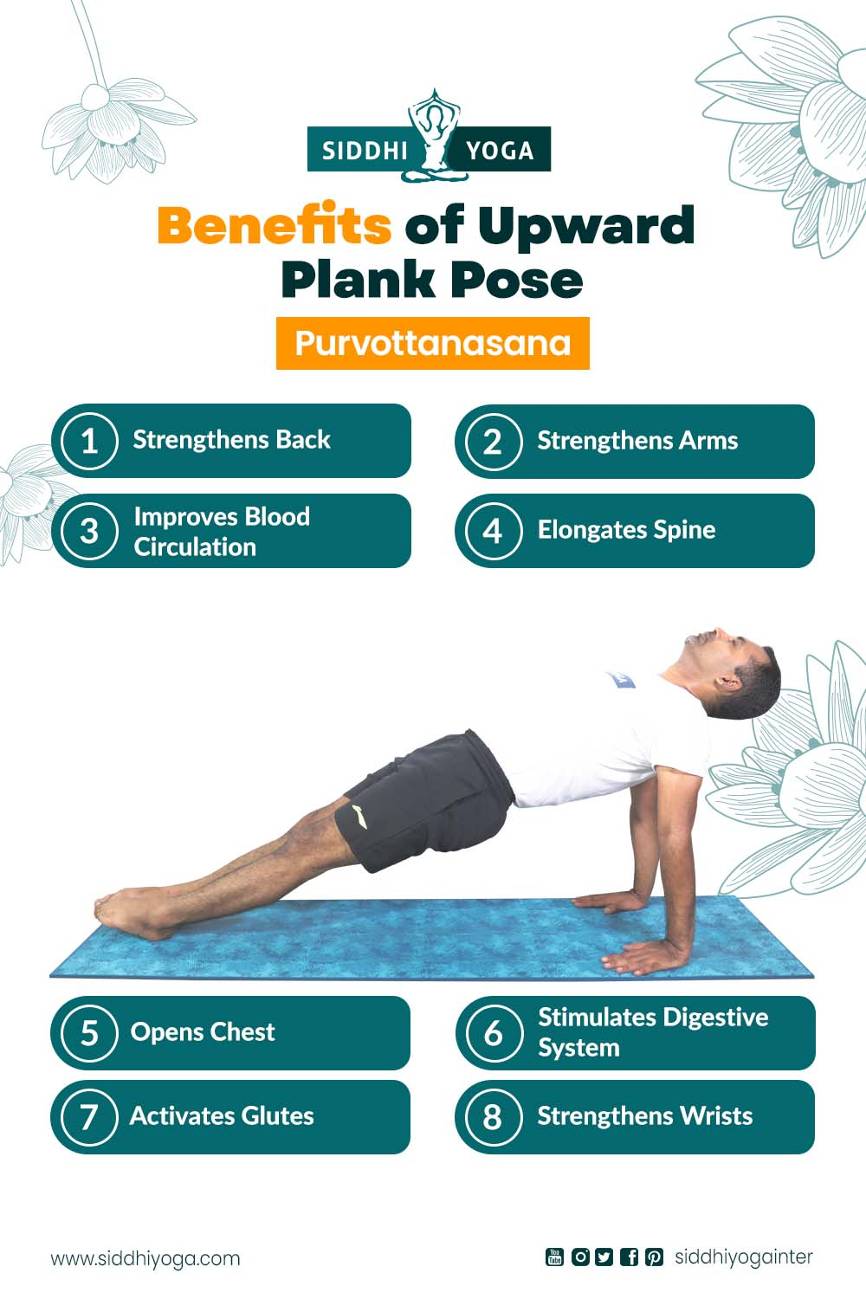
Eastward-Facing Stretch,
Reverse Plank Pose
ut: “intense”
tana: “stretched”
āsana: “posture”
Purvottanasana at a Glance
Purvottanasana is an Eastward-Facing Stretch or Upward Plank Pose or Reverse Plank Pose. In our sedentary lifestyle, in today’s world, there are a lot of health factors we need to deal with. Precaution is always better than cure. Purvottanasana yoga pose could help deal with stress, body pain, and bad posture, improve focus, and increase self-awareness. This pose stretches the body from head to toe.
Benefits:
- Purvottanasana helps to stretch your entire body to stretch and strengthen it.
- It gives better blood supply to the muscles and makes them stronger.
- Purvottanasana helps improve your respiratory system’s functioning as it opens up your chest.
- It engages your core abdomen and helps stimulate and improve the liver and kidney functions.
- It helps strengthen and tone the thighs, leg, and shoulder muscles.
- It increases your self-confidence and awareness of your body and mind.
Who can do this pose?
Intermediate or advanced-level yoga practitioners can do Purvottanasana or upward plank pose. People with good levels of upper body strength can do Purvottanasana. People who want to strengthen their arms and legs and improve their core strength can practice the Purvottanasana plank pose.
Who should not do this pose?
People with back, neck, legs, arms, or wrist injuries should not do this pose. For any recent surgeries, people should avoid it. People with high blood pressure should avoid doing this pose. Beginner should not do it on their own. Pregnant women should avoid it. Avoid if you have severe migraine or carpal tunnel syndrome.
How to Do Purvottanasana?
Follow the Step by Step Instructions
- Remember to prepare your body for this deep stretch and do the preparatory poses while practicing Purvottanasana. In the initial stages, do it under the guidance of the yoga teacher and follow the instructions.
- First, sit in the staff pose, your legs extended forward. Keep your hand behind your hips and fingers facing your body and take a few breaths.
- Keep your knees bent and your feet flat (hip-width distance) on the ground.
- Inhale deeply, press your palms and feet (push through your thumbs and big toes) against the ground, and lift your hips (roll your inner thighs) up off the floor by tucking your belly in and squeezing your hips.
- Now lift your chest and pelvis, and your arms are straight, feet flat (firm grip) on the ground, toes facing outside in the front.
- Engage your core muscles while lifting your hips.
- You can gently drop your head, roll your shoulders back, and open your chest.
- Keep breathing gently and hold the pose for 6 to 10 sec or as per your comfort.
- When you come out of the Purvottanasana, breathe in gently, look at your feet, and slowly bring your hips down and arms to normal position.
- You can do the crocodile pose as a counter pose.
What are the Benefits of Purvottanasana?

- Purvottanasana helps to stretch your chest, shoulders, legs, thighs, wrists, and front ankles.
- Purvottanasana improves your core strength and strengthens your arms, legs, and core and hamstring muscles.
- Reverse plank improves the thyroid gland function.
- Reverse plank helps to strengthen your abdomen and pelvic floor muscles.
- It elongates your spine and helps to open your chest.
- This is a good hip opener and stimulates your glutes.
Health Conditions that Might Benefit from Purvottanasana
- As this pose engages your abdomen, it strengthens and helps with digestion issues.
- This is a great pose as it opens up your chest muscles and helps improve your respiratory system’s functioning.
- Purvottanasana improves blood circulation throughout your body and brain, so it helps to relieve stress, tension, and anxiety.
- As the chest region and back muscles expand, it gives the adrenal gland more space to expand and secrete more hormones.
- This could be a good therapy for depression or fatigue from your everyday life.
- It helps to improve your spinal health by improving flexibility.
- It activates the Anahata chakra, which is good for your lungs and heart and improves your immune system.
Safety and Precautions
- Don’t drop your neck if you have a headache or strain in your neck.
- If you have high blood pressure, don’t perform Purvottanasana.
- Do Purvottanasana on an empty stomach and an even and soft surface.
- Any injury in your wrist, ankle or back should avoid doing Purvottanasana.
Common Mistakes
- Not doing the preparatory poses before Purvottanasana.
- Doing it after meals.
- Wrists should be under your shoulders.
- Avoid dropping your hips.
- Beginners always do it under the guidance of the yoga teacher.
Tips for Purvottanasana
- Beginners follow the instructions given by your yoga teacher.
- If you feel pain or are uncomfortable during the pose, just come out and ease.
- Use props in your initial stage for better comfort.
- You can do a child’s pose to cool down after the Purvottanasana pose.
Physical Alignment Principles for Purvottanasana
- Follow the Purvottanasana steps for the proper alignment.
- Sit in the staff pose with your legs straight.
- Hands behind the hips, fingers pointing to you.
- While you lift your body in the upward plank pose, your feet (feet firm) should be flat on the ground.
- Your legs and arms are straight. Your palms are under your shoulder blades.
- This pose works with the internal rotation of the thighs.
- You can drop your head at the back or keep your chin to your chest.
- Your back should align with the neck, and your shoulders should roll back.
- Engage your core muscles, thighs, and legs in the reverse plank pose.
- While coming out of the pose, gently bring your hips down.
Breath and Purvottanasana
Take deep, gentle breaths while in staff pose to center yourself for the upward plank pose. Inhale deeply when you leave your body off the floor. While you hold the pose, keep breathing to maintain balance and stability and engage your core. Inhale and slowly come out of the pose by bringing your hips down, sit on the mat, and take gentle breaths.
Purvottanasana and Variations
- Purvottanasana with bending your knees (reverse table topPose).
- Lifting one leg while you are in Purvottanasana (upward plank pose).
- Upward plank poses with props, and place yoga blocks under your hands.
- You can do a Side upward plank or a dynamic upward plank.
Take Away
Purvottanasana (upward plank pose) is a very powerful yoga pose. Practicing complementary poses like Purvottanasana and Pashcimottanasa will help to build strength that helps strengthen and improve the flexibility of your entire body. It is a wonderful pose to counter the effects of working by sitting longer on your system. Don’t try to do it alone if you are new to this pose. For benefits, get proper guidance from your yoga teacher. This improves your focus and concentration. It helps to increase your balance, relieve stress and anxiety and improve your confidence level.
Are you passionate about yoga and dream of teaching others? Our comprehensive yoga teacher training courses have got you covered! Explore the 200-Hrs Yoga Teacher Training Course, delve deeper into your practice with the 300-Hrs Yoga Teacher Training Course, or master the art of teaching with the 500-Hrs Yoga Teacher Training Course – all certified by Yoga Alliance. Your journey towards becoming a certified yoga instructor begins here. Join us today and let your yoga journey blossom!
Responses